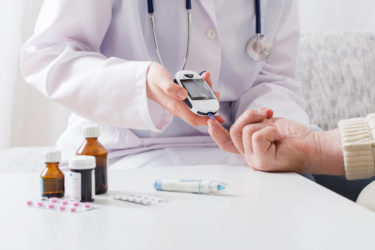What is diabetes? What every caregiver should know.

Did you know that 1 in 3 adults is at risk to develop Type 2 diabetes?
This risk gets worse as people grow older and organs don’t function as well as they used to.
In this post, I will be explaining exactly what Type 2 diabetes is, the symptoms associated with the disease, and why you or your elderly loved one needs to see a doctor immediately to manage diabetes.
Understanding Type 2 Diabetes
When you eat, your body breaks down food into different molecules that are then transported in your blood to your cells so that they can perform the functions that are necessary for life.
One of the major molecules that is broken down from your food is glucose (sugar). Glucose is an important source of fuel for your body and is at the core of many important biological and chemical processes in your body.
Glucose is transported in your blood to your cells.
You can think of your cells as a house with a door.
The key to that door is another chemical produced by your body called insulin.
In a non-diabetic person, insulin “opens the door” to your cells and allows glucose to enter into your cells.
In Type 2 diabetes however, insulin does not function properly and so glucose is unable to enter into the cells.
This results in high concentrations of sugar in the blood (this is not where sugar should be!) and ultimately results in Type 2 diabetes.
Now you’re probably thinking “But why would insulin suddenly not function properly?”
There are a few reasons why this might happen.
- It could be that your pancreas- the gland in your body which produces insulin- does not produce enough insulin
- Or it could be that even though there is insulin, your cells are resistant to the insulin for some reason and thus not allowing glucose to enter your cells.
Whatever the case is however, Type 2 diabetes is a serious condition that requires medical attention.
Symptoms of Type 2 Diabetes
Symptoms of Type 2 diabetes include:
- Increased urination. You notice that your elderly loved one has the need to urinate more than before.
- Increased thirst.
- Increased hunger. Because glucose does not enter your cells like it should, you experience intense hunger.
- Sudden unexplained weight loss.
- Fatigue.
- Blurred vision.
- Wounds that are slow to heal. Infections may be difficult to clear as well because your immune system is somewhat compromised.
Risk Factors for Type 2 Diabetes
Where there’s smoke, there is usually fire right?
Although scientists are not completely sure what causes diabetes, the following are risk factors associated with the disease.
Reducing/managing these risk factors can also reduce the onset of Type 2 diabetes.
- Obesity.
- Family history. If a parent or sibling has had Type 2 diabetes, it increases your risk significantly. And even though this is not a risk factor you can modify, modifying other things can keep the disease at bay.
- The risk of type 2 diabetes increases with age. The risk goes up significantly after age 45.
- Lack of physical activity. Physical activity helps you lose weight, and makes your cells more responsive to insulin.
- Race. African Americans, Asian Americans and Native Americans are more likely to develop Type 2 diabetes compared to Caucasians.
- Gestational diabetes. This is true for women who had a temporary form of diabetes while they were pregnant.
- An unhealthy diet.
As you can see, while many of these risk factors are things you can’t help, losing weight through physical activity and a healthy diet will help to significantly reduce your risk for diabetes.
What can you do as a caregiver?
As a caregiver, the best thing you can do for an elderly loved one with diabetes is to help them pay attention to medical advice.
Diabetes is a disease that appear “not serious” until complications develop.
Usually, those complications are hard to treat and can be fatal.
Thus your job as a caregiver is to encourage your loved one to:
- Eat healthy
- Maintain a healthy weight
- Exercise– even 30 minutes of exercise three times weekly can do wonders
- Take medicines that are prescribed to them. You will also have to pay attention to any side effects of prescribed medication so that you can report them immediately
- Watch your loved one for complications of diabetes (we will talk about this in another blog post).
Closing Thoughts
Diabetes is one of those disease that can “lurk” in the background until it is too late.
Now that you’re equipped with the knowledge of what Type 2 diabetes is, take action for yourself or your elderly loved one before it is too late.
Enjoyed this post?
Share it with someone else so they know too.
